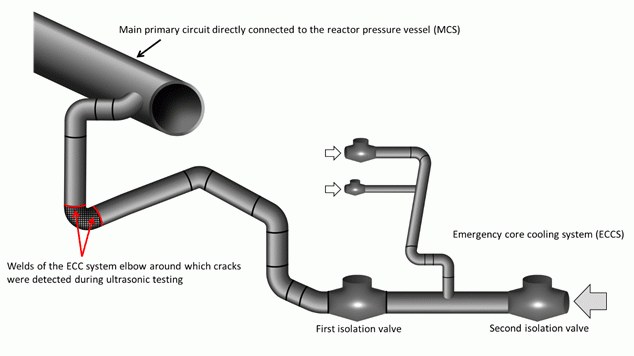Detection of cracks in pipes of the emergency core cooling system of the reactors 1 and 2 of the Civaux NPP
During the ten-yearly in-service inspection of reactor 1 of the Civaux nuclear power plant, which began on August 21, 2021, EDF performed ultrasonic testing of several welds in the emergency core cooling system, in accordance with the applicable preventive maintenance program. The examinations revealed the presence of faults near the welds of some pipe elbows.
The emergency core cooling system (ECCS) is a safety system that njects borated water into the reactor main coolant circuit (also called main primary circuit) to cool the core in the event of a breach affecting the main coolant circuit. The objective is thus to maintain a sufficient water level in the core to cool the fuel assemblies.
The emergency core cooling system is made up of two independent safeguard trains connected to the primary circuit via a hot leg [1] and cold leg [2] connecting pipe of each of the four loops of the primary circuit.

Ultrasonic examinations carried out on Civaux reactor No. 1 revealed the presence of faults near the welds of some pipe elbows (see figure). In accordance with the applicable preventive maintenance program, examinations were then extended by EDF to adjoining welds. In order to determine the origin of these cracks, the pipes were cut, and the welds involved have been sent to the laboratory for expertise. By metallographic and microscopic examination, EDF was thus able to determine the nature and depth of the faults detected. The origin of faults seems to be stress corrosion cracking.
Stress corrosion is a mode of damage that typically results from the combined action of mechanical stress and an aggressive environment with respect to the material. In order to better understand the factors behind the observed corrosion, EDF has undertaken a verification of the manufacturing files. At the same time, it carries out a performance review of the control procedures used. These analyzes aim to develop a verification program for welds likely to be affected by the phenomenon.
If these faults develop in the emergency core cooling system piping, it could lead to a leak or a break. If this break occurs on a pipe, this leads to a loss of coolant accident, the damaged elbows being located downstream of the isolation valves of the emergency core cooling system. The emergency core cooling system train unaffected by the breach would then ensure the injection of water into the primary circuit and the cooling of the core. If, on the other hand, this rupture or leak occurs simultaneously on several pipes, the cooling of the reactor core could potentially no longer be ensured. Events such as an earthquake (generating mechanical stresses in the involved pipes) or start-up of the emergency core cooling system (causing cold water to enter hot pipes) can simultaneously stress these circuits.
EDF decided to preventively shutdown Civaux’s No. 2 reactor on November 20, in order to carry out early examinations on the welds, the ten-yearly outage of the reactor being scheduled in a few months. The first results of examinations on this reactor show the presence of defects at the same welds as on reactor No. 1. EDF therefore decided to unload the fuel assemblies from the core of reactor No. 2 to proceed to in-depth investigations and to the repairs that may prove necessary.
As a generic anomaly relating to the 1,450 MWe reactors cannot be ruled out at this stage, EDF has decided to shut down the two reactors at the Chooz B nuclear power plant in the Ardennes from December 16, which are of the same type as those of Civaux (1450 MWe reactors), in order to carry out checks.
IRSN considers that EDF's decision to shut down the two Chooz B reactors, in addition to the two Civaux reactors, is satisfactory from a safety point of view. Examinations on Chooz B's reactors will determine whether they are affected by the same defects. In-depth investigations must be carried out in order to determine the phenomena at the origin of stress corrosion cracks and to define the scope of the examinations to be carried out.
Specific examinations may also be necessary on other reactors in operation.
Download IRSN information report of December 16, 2021: Detection of cracks in pipes of the emergency core cooling system of the reactors No. 1 and No. 2 of the Civaux nuclear power plant (PDF)
Notes:
- After the reactor pressure vessel outlet.
- Before the reactor pressure vessel inlet .
